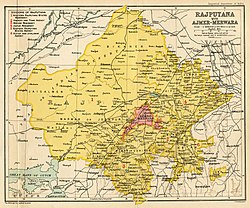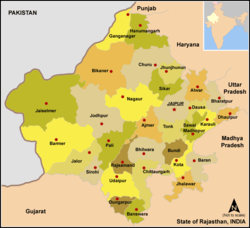


Rājputāna was the pre-1949 name of the present-day Indian state of Rājasthān, the largest state of the Republic of India in terms of area. During British period, this area had 23 Princely states, as well as one chiefdom, one estate, and the British district of Ajmer-Merwara. Most of the ruling princes were Rajputs, the warrior rulers who entered the region in the 7th century AD. The largest states were Jodhpur, Jaisalmer, Bikaner, Jaipur, and Udaipur. In 1947 the Princely states were consolidated and the princes were pensioned off.
Name
George Thomas (Military Memories) was the first in 1800 A.D., to term this region as Rajputana.[1] The historian John Keay in his book, India: A History stated that the Rajputana name was coined by the British, but that the word even achieved a retrospective authenticity: in an 1829 translation of Ferishta's history of early Islamic India, John Briggs discarded the phrase Indian princes, as rendered in Dow's earlier version, and substituted Rajpoot princes.[2] It was essentially the country of the Gurjars.[3][4] Historian R. C. Majumdar explained that the region was long known as Gurjaratra (Country protected by the Gurjars or Gurjar nation), early form of Gujarat, before it came to be called Rajputana, early in the Muslim period.[5]
Geography
The area of Rajputana is estimated to be 132,559 square miles (343,328 square km) and breaks down into two geographic divisions:
- An area northwest of the Arāvalli Range including part of the Great Indian (Thar) Desert, with characteristics of being sandy and unproductive.
- A higher area southeast of the range, which is fertile by comparison.
The whole area forms the hill and plateau country between the north Indian plains and the main plateau of peninsular India.
See also
Notes
- ^ F. K. Kapil (1999). Rajputana states, 1817-1950. Book Treasure. p. 1. Retrieved 24 June 2011.
- ^ John Keay (2001). India: a history. Grove Press. pp. 231–232. ISBN 0802137970, ISBN 9780802137975.
Colonel James Tod, who as the first British official to visit Rajasthan spent most of the 1820s exploring its political potential, formed a very different idea of "Rashboots".....and the whole region thenceforth became, for the British, 'Rajputana'.The word even achieved a retrospective authenticity, in 1829 translation of Ferishta's history of early Islamic India, John Briggs discarded the pharse 'Indian princes', as rendered in Dow's earlier version, and substituted 'Rajpoot princes'.
- ^ Sir Jivanji Jamshedji Modi (1930). Dr. Modi memorial volume: papers on Indo-Iranian and other subjects. Fort Printing Press. p. 521.
Rajputana was essentially the country of the Gurjaras, Gujarat came to be called after...
- ^ Asiatic Society of Bombay (1904). Journal of the Asiatic Society of Bombay, Volume 21. p. 416.
But this much is certain that Rajputana was essentially the country of the Gurjaras
((cite book)): Unknown parameter|coauthor=ignored (|author=suggested) (help) - ^ R.C. Majumdar (1994). Ancient India. Motilal Banarsidass Publ. p. 263. ISBN 8120804368, ISBN 9788120804364.
References
- Low, Sir Francis (ed.) The Indian Year Book & Who’s Who 1945-46, The Times of India Press, Bombay.
- Sharma, Nidhi Transition from Feudalism to Democracy, Aalekh Publishers, Jaipur, 2000 ISBN 81-87359-06-4.
- Webb, William Wilfrid The Currencies of the Hindu States of Rajputana, Archibald Constable & Co., Westminster, 1893.
- Rajputana, Encyclopædia Britannica.